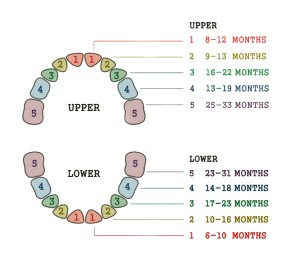Every parent knows teething is coming. You have heard stories, read about symptoms, and maybe even stocked up on teething toys long before that first tooth appeared. But when your baby starts drooling nonstop or chewing on whatever they can grab, it becomes real. Even when you expect it, teething still brings new emotions, new routines, and sometimes… new questions.
The good news is that teething is a healthy and exciting developmental milestone. Those tiny teeth mean your baby is growing and getting ready for big steps like trying new foods and learning speech sounds. While some days may include fussiness or extra clinginess, there are many simple ways to comfort your little one and keep them smiling.
In this blog post, we will walk through what teething looks like, how to soothe sore gums, and which remedies are truly safe and effective.
When Does Teething Start
Babies’ teeth start forming before they are born. Tooth buds begin growing during the second trimester. Once babies are born, the roots grow, and the teeth push up until they break through the gums.
 Teething usually begins around six months of age. Although starting sooner or later can still be perfectly normal. Some babies show early signs even before a tooth is visible. Others may wake up one morning with a tooth suddenly peeking through. Every baby’s timeline is unique, and that’s completely okay.
Teething usually begins around six months of age. Although starting sooner or later can still be perfectly normal. Some babies show early signs even before a tooth is visible. Others may wake up one morning with a tooth suddenly peeking through. Every baby’s timeline is unique, and that’s completely okay.
You may notice a pattern. A teething phase begins, a tooth pops through, things calm down, and then the cycle repeats. By age three, most children have all 20 of their primary teeth. Watching this progression can be a sweet reminder of how quickly little ones grow.
Signs of Teething: What Is Normal and What Is Not
Every baby responds to teething in their own way. Some barely notice a thing, while others may be more sensitive to gum pressure.
Common signs of teething include:
- Drooling more than usual
- Chewing on fingers, toys, or clothing
- Extra clinginess, fussiness, or crying
- Swollen or red gums where a tooth is developing
- More night waking or shorter naps
- Reduced interest in eating
- Tugging at their ears or rubbing their cheeks
These signs can come and go, and many babies find comfort simply by being close to you during these moments.
Simple Ways to Comfort Teething Babies and Toddlers
You don’t need fancy gadgets or special products. Most babies find relief with simple, safe comforts that help ease pressure and cool their gums. Below are gentle, parent-friendly ideas that can make a big difference.
Try a chilled teething ring
Cold naturally reduces inflammation. Place teething rings in the refrigerator, not the freezer. Extremely hard, frozen items can be uncomfortable or even damage delicate gum tissue. If you do not have a teething ring on hand, a chilled washcloth works well. The cool texture offers both pressure and relief.
Silicone teething toys
Silicone toys provide just the right amount of pressure. Look for BPA free toys that are easy to grip and clean. To provide additional soothing, place silicone chew beads or toys in the fridge before offering them to your child.
Note: Be wary of liquid or gel-filled teething toys. These can easily break when chewed on by toddlers who already have multiple teeth in their mouths. Additionally, these toys can become too hard when frozen and cause damage to teeth and gums.
Massage the gums
Wash your hands and gently rub your baby’s gums with a clean finger or damp gauze pad. Many babies find this incredibly calming. This technique gives them immediate relief and gives you a chance to connect through touch. A soft, slow circular motion can be especially soothing.
Offer teething-friendly snacks (if your baby eats solids)
Cold, soft foods can help soothe gums from the inside out. Baby safe options include:
- Chilled cucumber sticks
- Frozen fruit in a mesh or silicone feeder
- Cold applesauce or yogurt
Use distraction
Sometimes the best comfort is a change in scenery or activity. A walk outside, a warm bath, singing together, or a quiet cuddle can help shift focus away from gum discomfort. Even a few minutes of fresh air can reset their mood, and yours.
Over-the-Counter Pain Medications
Over-the-counter pain medications, such as children’s ibuprofen and acetaminophen, are sometimes the best solution for a toddler who is experiencing extreme teething pain. Be sure to follow the directions on the package when giving these medications to your child. If you’re unsure about dosing, your pediatrician can always help.
Nursing or Breastfeeding
If your little one is still breastfeeding or nursing, offering breastmilk in a cup can go a long way in providing comfort and pain relief. It can also be a soothing moment of connection during a tender phase.
What to Stay Away From When Teething Starts
Even though parents prepare for teething, it is easy to feel overwhelmed by the sheer number of teething products available.
Skip these items:
- Over-the-counter teething gels containing benzocaine or lidocaine. These can be unsafe for infants.
- Amber teething necklaces. They pose a strangulation and choking hazard.
- Frozen solid toys. These can be too hard and may injure sensitive gums. (The FDA has issued safety warnings about benzocaine use in babies — learn more here.)
For more safety guidance, the AAPD Parent Resource Center is a great resource:
https://www.aapd.org/resources/parent/

Caring for Baby’s Teeth as They Come In
Teething is a great time to introduce early oral care. As those first teeth appear, small daily habits can help your baby get comfortable with brushing and set the stage for a healthy smile. Here are a few tips to try.
Start brushing early
Use a soft, infant toothbrush with a rice-sized smear of fluoride toothpaste. Brush twice a day, especially before bedtime. Fluoride strengthens enamel and protects against cavities as each new tooth appears. Making brushing part of your routine helps little ones learn quickly.
Skip bedtime bottles
Milk or juice before bed can rest on your baby’s teeth and contribute to what’s known as baby bottle decay. Because these sugars sit on the teeth for hours, they can slowly break down enamel and lead to early childhood cavities. If your little one needs a bottle to fall asleep, offering water instead can help protect those new teeth as they come in.
Schedule your baby’s first dental visit by age one
The first visit is gentle, quick, and focused on helping your little one feel comfortable. During a Baby & Me Visit, one of our pediatric dentists will check your baby’s teeth and gums, answer your questions, and share simple brushing tips. Early dental visits help little ones feel happy, comfortable, and confident as they grow.
When to See a Pediatric Dentist
Sometimes, toddlers can develop an eruption cyst where a tooth is beginning to break through the gum. These can seem alarming, but usually resolve on their own. Because the tooth erupts through the cyst, treatment is usually not necessary. If the cyst does not rupture spontaneously or becomes infected, the top of the cyst can be easily removed by your pediatric dentist.
As a general rule, if you see or feel anything that seems unusual, you should certainly see your pediatric dentist. We are always happy to answer any questions or see your child if you have any concerns.
You are doing a wonderful job. And your baby is, too.
Teething signals growth, change, and new milestones ahead. Each tiny tooth is a step toward new foods, new sounds, and new learning. You know your baby better than anyone else. Trust your instincts, lean into the soothing strategies that feel natural, and remember that this phase is temporary.
We’re here to help guide you through teething, brushing routines, and every stage of your child’s smile.
Call us today at (904) 215-7800 to schedule your child’s appointment at Growing Healthy Smiles.
